The iPhone 6 Review
by Joshua Ho, Brandon Chester, Chris Heinonen & Ryan Smith on September 30, 2014 8:01 AM EST- Posted in
- Smartphones
- Apple
- Mobile
- iPhone 6
Display
As the primary mode of interaction with the phone, the display is one of the most important areas of evaluation. Of course, the methods of evaluation can be hotly debated. There is a great deal of subjectivity in this area in terms of what someone prefers. However, for the sake of color calibration our tests follow world-wide standards instead of personal preference one way or another. This means that we use the sRGB gamut and 2.2 gamma, which most content is adapted to. While AdobeRGB and other gamuts exist, these are for limited use cases and only applicable to operating systems that are aware of multiple gamuts and can dynamically switch between them depending upon the metadata of the content. In order to accurately test for how well a display conforms to these standards, we use SpectraCal’s CalMAN 5 along with a spectrophotometer for accurate color readings.
For those that are unfamiliar with the display of the iPhone 6 and Apple’s key marketing points on this new model, the improvements are mostly centered on higher resolution, contrast, and better viewing angles. In terms of higher resolution the iPhone 6 moves from the 1136x640 pixels of the iPhone 5/5s generation to 1334x750 pixels. However, this doesn’t improve the pixel density, which remains at 326 pixels per inch.
In practice, I definitely continue to notice the difference in resolution when using the iPhone 6 as opposed to the higher pixel density iPhone 6 Plus and the various Android smartphones with 450+ PPI displays. I definitely don’t find the resolution to be a problem though, as these issues only become significant to me below 300 PPI. I do think that around 450 to 500 PPI is the right place to be when balancing pixel density and power, but Apple’s choice should pay off in the form of better power consumption especially because LED backlights rapidly lose efficiency near the highest current region.
The other issue at hand is that of viewing angles. While Apple is one of the first to really talk about dual domain pixels, this technique is rather commonly used to improve viewing angles. The result is that a pair of pixels will appear to be a chevron, and overall the pixels appear to be squiggly in nature. While this doesn’t really change the readability of the display at extreme angles, colors like white no longer have noticeable red/yellow/blue shifts depending upon the angle that the display is shifted at.
This is definitely noticeable in everyday use, as the iPhone 5s could only avoid color shifting at certain angles instead of every angle. As I predicted in the launch article though, the one caveat seems to be that black has a noticeable shift towards purple in certain angles. There's also a noticeable hatching on close examination, but this doesn't affect image quality. This is definitely better than what I see on AMOLED though, as while AMOLED has much better brightness stability the color shifting is far more obvious and significant.

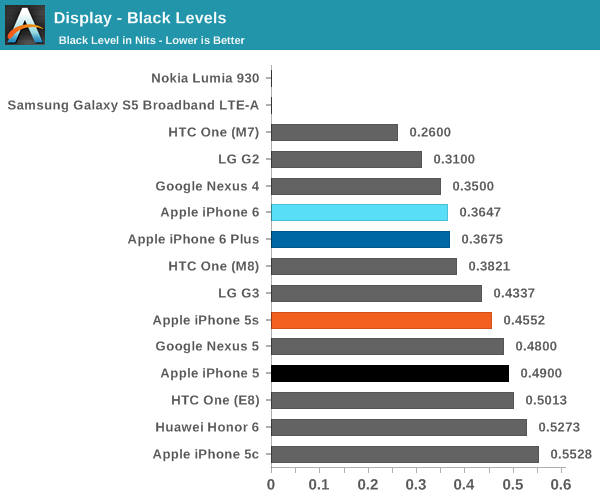

Now that we’ve covered the other two, we can talk about contrast. For this test, we measure brightness of 100% white and black at maximum display brightness, and look at the ratio. While we’re looking into getting patterns that can’t be defeated by dynamic contrast/backlight this should give an idea of best case contrast. In this case, peak brightness is on the high side at 560 nits, with relatively low black brightness at about a third of a nit. The result is one of the best contrast ratios I’ve ever seen. While the HTC One (M7) has a 1743:1 contrast ratio in our tests, some testing I’ve done indicates that the true contrast ratio is realistically around that of the One (M8). I’m not quite sure how this was done, but Apple stated that a new deposition process was used for the liquid crystals. This, along with changes to the liquid crystals themselves, could be responsible for the improved contrast.
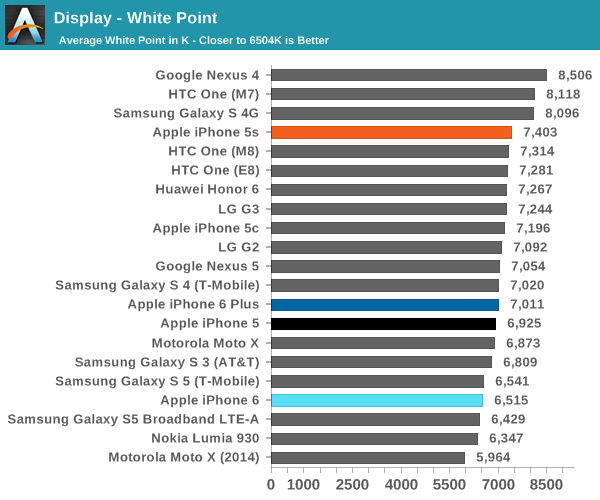
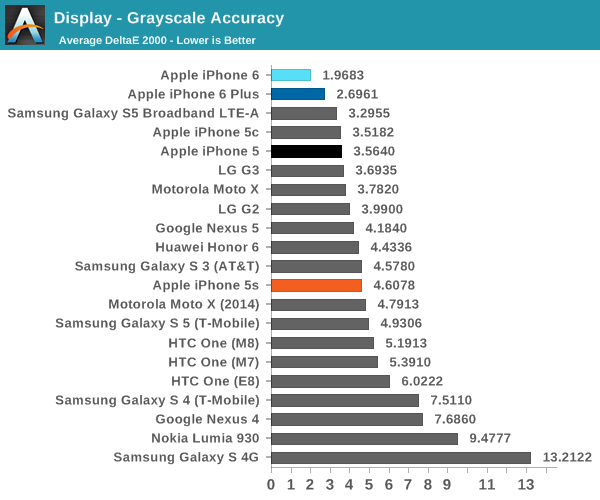
The next part to talk about is grayscale, which is an area where Apple seemed to prefer bluer color balances. I don’t really have much to pick at here, because the level of calibration here is incredible. While there is a noticeable trend of overshooting red at the low end and undershooting red at the high end, this is nitpicking at best. At any rate, this is essentially perfect.
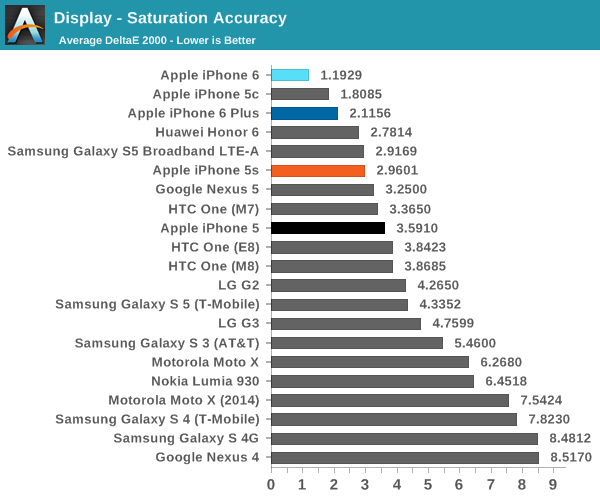
Our next test is the saturation sweep, which tests each primary and secondary color for accuracy in hue and luminance. While it’s true that humans can be relatively insensitive to differences in saturation, it is all too common to see OEMs artificially compress saturations to have vivid colors and be able to claim that they have an accurate display because it matches the sRGB gamut. In this test, the iPhone 6 sets a new record. I really don’t have any objections here because a dE2000 value of 1.19 is a deviation that is almost impossible to notice.
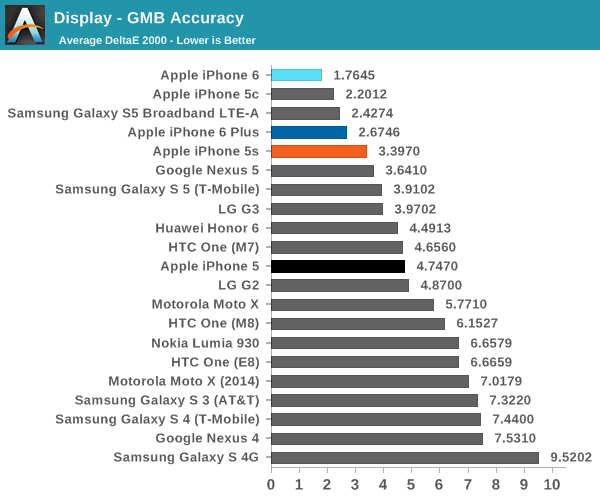
The final test is the Gretag MacBeth ColorChecker, which tests various hues and is usually one of the hardest tests to perform well in. In this regard, the iPhone 6 once again sets a new record for accuracy. This display is effectively calibrated to sRGB, and one would be hard pressed to find a significant deviation when compared to a reference monitor.
Overall, it’s hard to find any criticism for this display. I would normally be incredibly suspicious to see these numbers on a smartphone, but the fact that there’s a hot pixel in the center of the display suggests to me that this was not a cherry-picked unit. The fact that I find this level of calibration to be suspicious speaks volumes about how good this display is. While contrast isn't AMOLED levels of black, there are no purple smearing effects, noticeable uneven luminance near black, or any other idiosyncrasies.


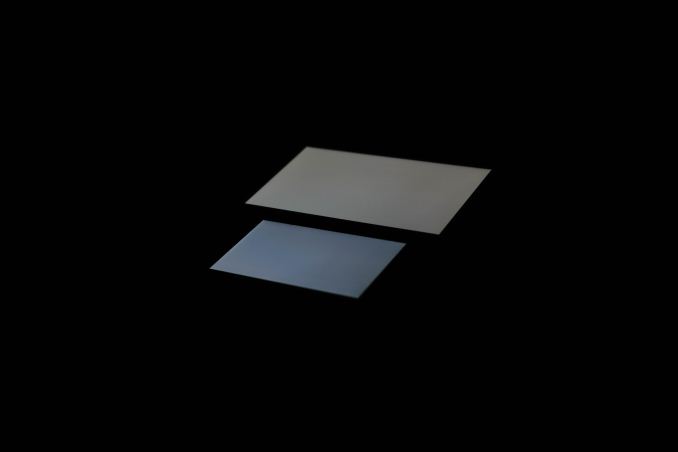
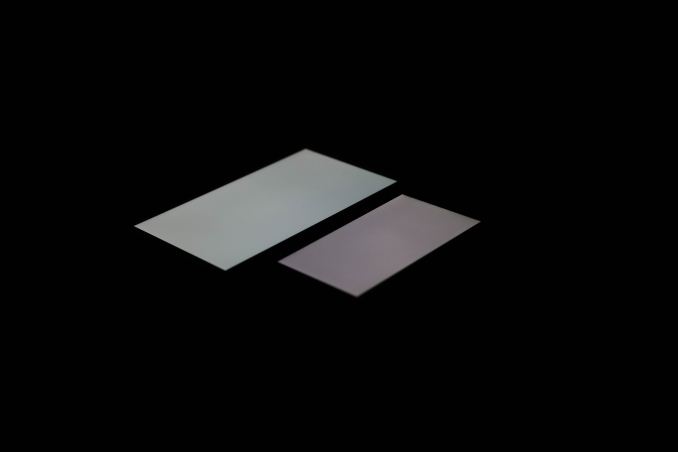
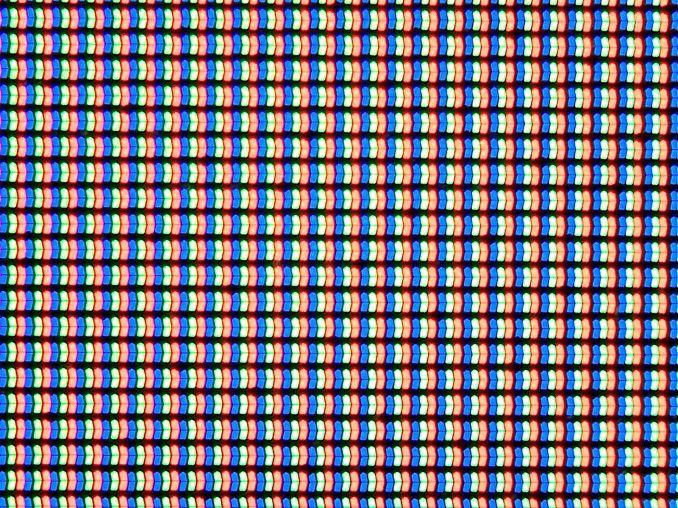

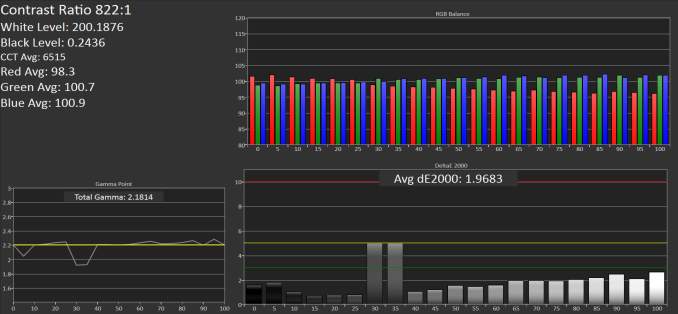

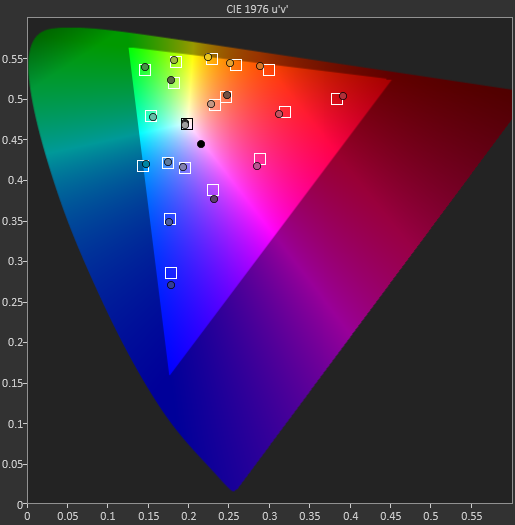








531 Comments
View All Comments
Parhel - Tuesday, September 30, 2014 - link
Inevitably stop working? If you really have that many cable failures maybe it's the Radio Shack cables that are the problem? I've never heard of one of them failing. Maybe try Monoprice. They have a line with metal housing on the connectors and they're cheaper than the Apple ones.mrochester - Wednesday, October 1, 2014 - link
I just use the ones that come in the box with the iPad or iPhone. Cost = free :)GerryS - Wednesday, October 1, 2014 - link
I've never had a cable failure with any Apple cable, except those I abused (and even most of those are going strong 2-3 years later). If your wife's cables are failing predictably, it has something to do with how it's being used. That's not to say she's mis-using it - it may simply be that her use involves additional strain. Perhaps she uses a car mount or other device that kinks the cable at the end?shm224 - Thursday, October 2, 2014 - link
in my experience, both micro usb and lightning crap out after some use. The only difference is that it cost on average 4-5 times as much to replace a Apple cable.GerryS - Wednesday, October 1, 2014 - link
Actually, I've never had a problem with the 30-pin connector (I believe they replaced it mostly for size reasons), nor with microUSB. I'm somewhat unconvinced there's a strong argument for Apple not to use microUSB. There may be one, but I've not heard it.Stuka87 - Tuesday, September 30, 2014 - link
How is the lightning connector defective? Personally I love it. It has no pins to break like a USB connector, does not have to be inserted in one specific direction, and works quite well overall.mrochester - Tuesday, September 30, 2014 - link
I don't think Apple are interested in the low end. Apple's strategy is to make fewer devices, but more profit from each one. It seems to be the best strategy.WinterCharm - Tuesday, September 30, 2014 - link
They bend after applying 70 lbs of force. Thats a LOT.Can you bend them by hand? sure
But it's not possible to bend them unless you were TRYING to damage them. Ie, during normal use they shouldn't bend.
GerryS - Wednesday, October 1, 2014 - link
Agreed. I feel certain I could also bend my laptop screen if I wanted. I don't want.bigstrudel - Tuesday, September 30, 2014 - link
The only people that don't like the Lightning connector also don't own any Apple devices that use one.